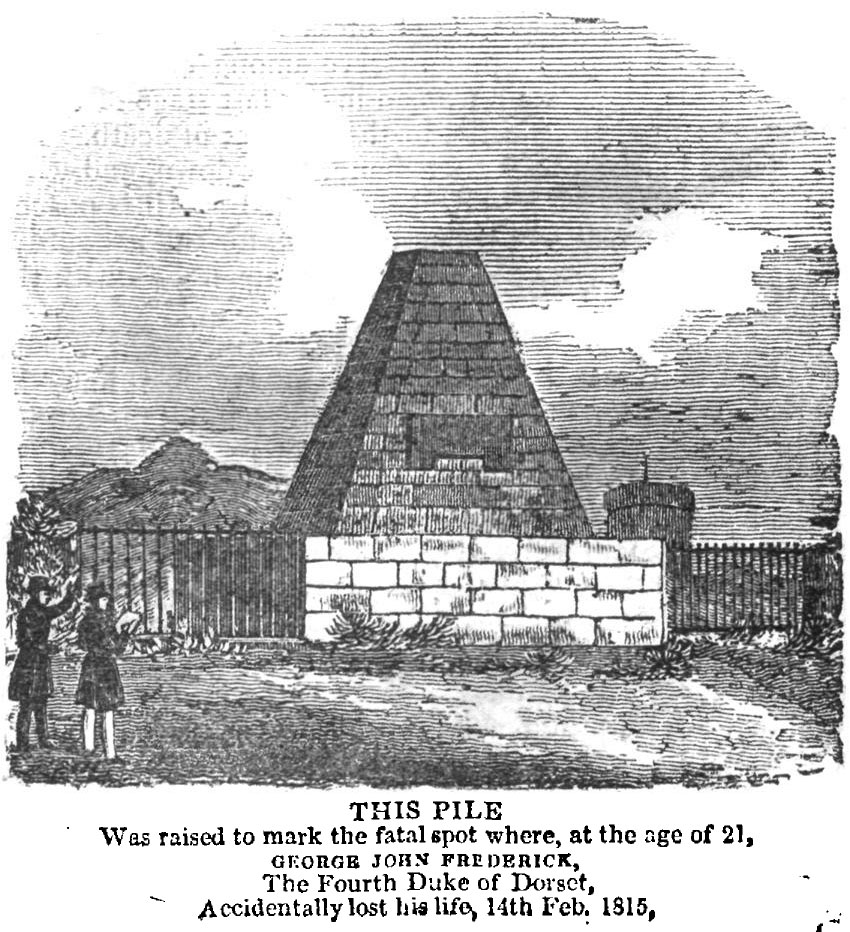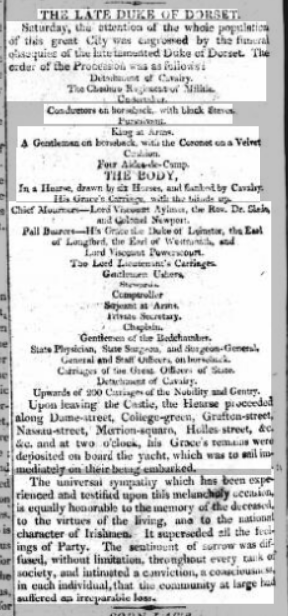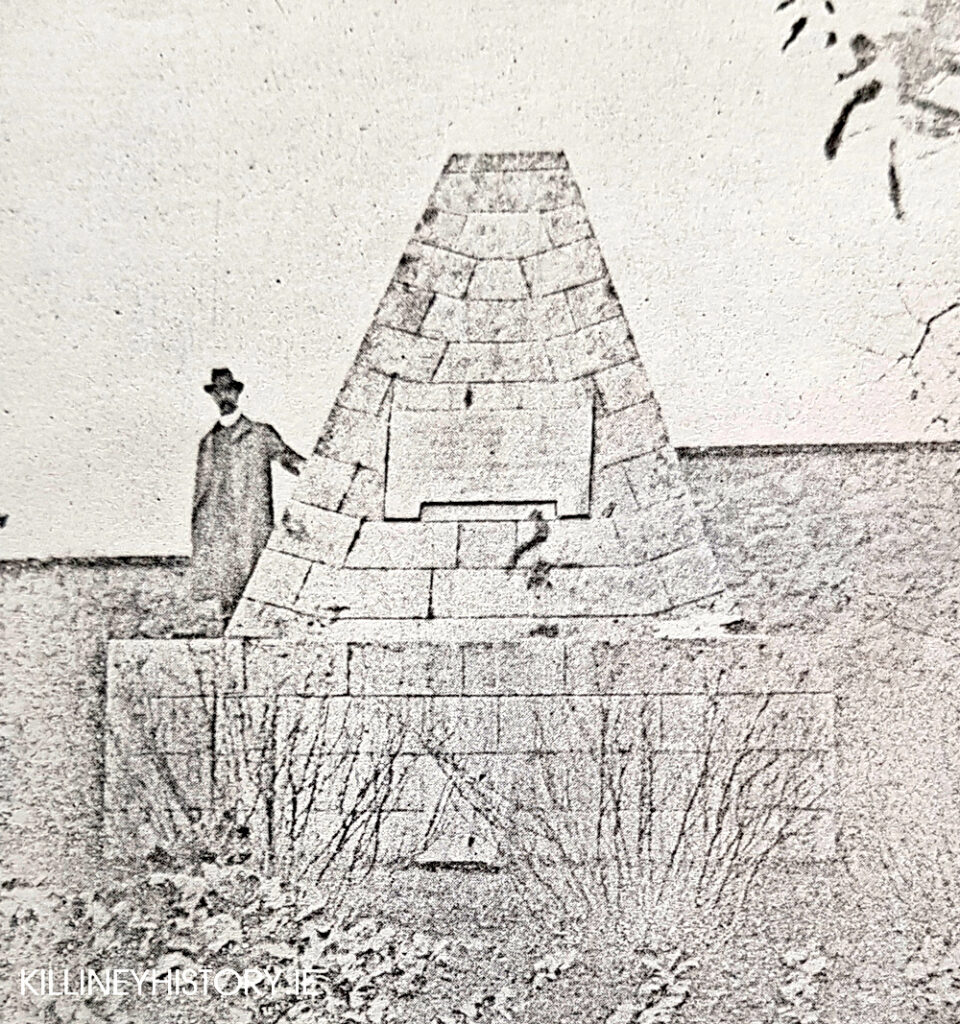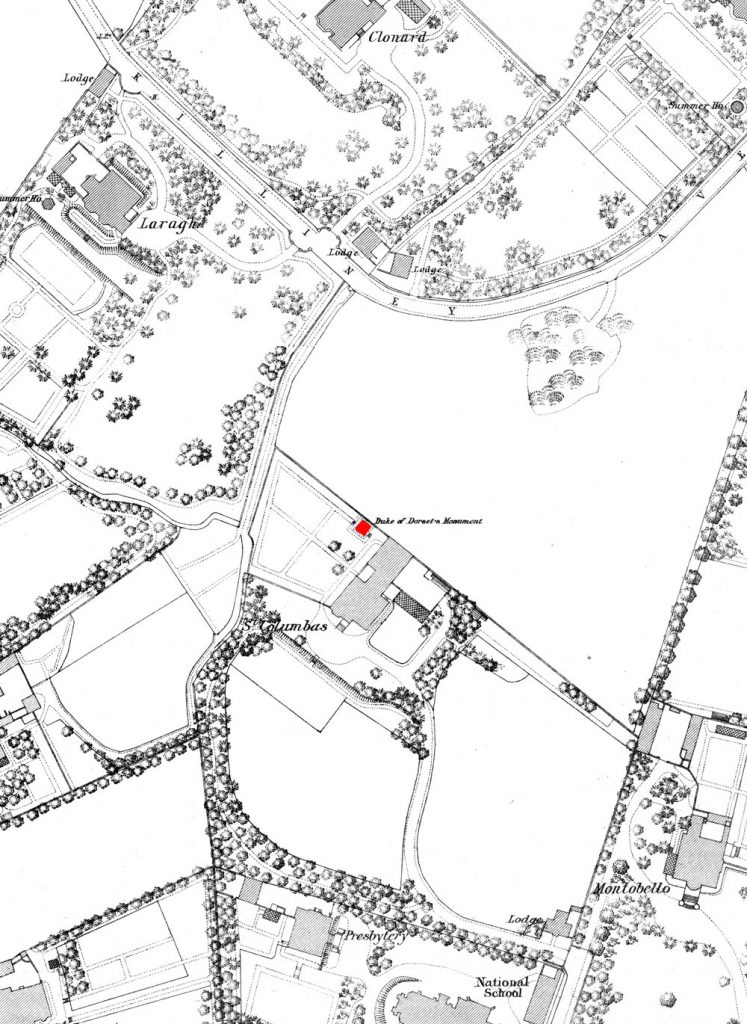
From an article by Pól Ó Duibhir
Read to the Old Dublin Society, 16th March, 1977
Although the area was beginning to become more a residential than an open hunting area at this stage, Lord Powerscourt’s pack were still hunting in Ballybrack in 1815. It was on one of these outings that the fourth Duke of Dorset, then only 21 years of age, was killed in a fall from his horse in the grounds of what is now St. Columba’s. the Freeman’s Journal carried a report of the incident two days later explaining that the Duke’s horse had come a cropper on some loose stones but preserving his ducal dignity even to the end by informing the public that His Grace had come to the ground on his breast. The young Duke was held in such respect by those who knew him, says the reporter, that had he lived he would no doubt have succeeded his stepfather Lord Whitworth as Viceroy. The report ends with a verse from an already well worn poem:
The boast of heraldry, the pomp of power
And all that station all that wealth ere gave
Await alike the inevitable hour
The paths of glory lead but to the grave
A substantial obelisk was erected to mark the spot where the Duke met his untimely end.
A more fitting tribute might have been to have quoted from the hundred and twelve line poem which Byron wrote to the Duke when he was the poet’s fag at Harrow. Byron’s advice to the Duke was to shun those who would make up to him for his rank, and while respecting his forbears, make a career for himself through his own efforts. Fine sentiments but alas in vain. Byron’s poem, while written in 1805, was not published till much later and was perhaps fortunately not around at the time of the Duke’s death to embarrass his family with memories of the warm relationship which had existed between the two boys ten years earlier. With the Duke’s death, however, came the end of an era for Ballybrack. The “Developers” were already moving in.

The Kilruddery Hunt and other notes by William Fernsley Figgis in ‘Killiney Surroundings’
Hunting over the Killiney Hills prevailed at least as early as 1744 when it was celebrated in the famous ballad known as The Kilruddery Hunt.
“We rode from Kilruddery in search of a fox (The Loughlinstown landlord, the bold Owen Bray) To Malpas high hill was the way that he flew”.
The Owen Bray alluded to was a character of much account, “He kept a notable Inn at Loughlinstown just opposite the big tree, probably where now stands Beechwood.”
For ¾ of a century longer this was a happy hunting ground until the year 1815, when on the 14th February a fatal accident occurred, while following the hounds in the very track described in this ballad. It was while hunting with Lord Powerscourt that the young Duke of Dorset (Stepson of Lord Whitworth who was Lord Lieutenant at the time) came to his unfortunate end. He took a leap over a low stone fence, not aware that on the other side was a pit; he and his horse fell together and when taken up he was wholly senseless; he was brought alive to Powerscourt’s house Enniskerry, but expired in less than an hour. A messenger was sent off at the moment of the accident to Lord Whitworth and the Duchess (formerly Duchess of Dorset and mother of the boy killed) but long before they could reach Powerscourt all was over. Lord Powerscourt was so deeply affected by this catastrophe, that he immediately disposed of his hounds and has never hunted since.
(Lady Plumtre’s Residence in Ireland).
In the grounds of St. Columba stands a stone memorial, marking the spot where the accident took place, bearing the inscription:- This Pile was raised to mark the fatal spot where, at the age of 21 George John Frederick The fourth Duke of Dorset Accidentally lost his life 14th February 1815.”
DUKE OF DORSET. Dr. Dickson has brought to our notice the reactions upon the poet Byron caused by the unhappy death of this nobleman.
In a letter to his biographer, Thomas Moore, dated Feb. 22 1815 he wrote:- I have just been or rather, ought to be much shocked by the death of the Duke of Dorset. We were at school together (Harrow), and then I was passionately attached to him. Since we never met, but once I think, since 1805, it would be paltry affectation to pretend that I had any feeling for him worth the name. But there was a time in my life when this event would have broken my heart; and all I can say for it now is that it is not worth breaking.
In his next letter to Moore dated March 2, 1818 – “I feel merry enough to send you a sad song.” This was the poem commencing – ‘There’s not a joy the world can give like those it takes away.’
Byron had also written the poem “To the Duke of Dorset” in 1805.
Newspaper reports of the fatal riding accident
Freeman’s Journal 16 February 1815
DEATH OF THE DUKE OF DORSET
It becomes our painful duty to state that Tuesday, about two o’clock, the Duke of Dorset was killed by a fall from his horse.
The circumstances which have attended this very sad calamity are very nearly as follows:- The Duke had been, since Monday, on a visit to Lord Powerscourt and Tuesday joined a hunting party in the vicinity of Killiney. His Grace entered warmly into the spirit of the chase towards its close, and when his horse was a good deal fatigued he leaped a small stone wall, at the opposite side of which, loose stones had been collected. The horse effected the leap, but fell among the stones, and his rider was consequently thrown off. His Grace came to the ground on his breast. He was unconscious of having been materially injured, for in reply to a question from Lord Powerscourt, who was near at the time of the accident, “if he was much hurt”, his Grace said, ” he believed not”. He was immediately taken to the house of Mr. Oxley, from which a messenger was instantly dispatched to town, for Surgeons Crampton and Macklin. Before their arrival, however, his Grace had expired. The Hon. Mr. Wingfield and Mr. Oxley, were with him when he died.
The Lord Lieutenant and the Duchess of Dorset, had been acquainted with the melancholy catastrophe as expeditiously as practicable, and set off for Powerscourt, where they expected to have found his Grace. Not meeting with him, or learning anything certain respecting the injury, they moved rapidly on towards Killiney, where his excellency was apprised of the extent of the calamity which had happened, timely enough to prevent the Duchess of Dorset from being a witness of it. Overwhelmed with the poignancy of their feelings, they returned to the Castle, where the body of the Duke was conveyed in Lord Powerscourt’s carriage.
His Grace was born in Nov 1793, was the fourth Duke and eleventh Earl of Dorset; the title devolves to the present Lord Viscount Sackville’s son to the celebrated Lord George Germaine.
The Family of Sackville came over with the Conqueror, and have ever since been distinguished. Jourdan D’Sackville was one of the persons elected by the Barons to compel King John to observe the charter. His grandson was one of the rebellious Barons taken prisoner by Prince Edward at the battle of Evesham. The family was ennobled by Elizabeth though at that time Catholic.
The Earldom was conferred by the first of the Steuarts, and the Dukedom by the first of the Brunswick family. The new Duke is a near connection of the Glendore family, and the Herberts of Kerry.
The amiable character and conciliating manners of this young Nobleman, have made his death the subject of general regret. He was distinguished for a peculiar affability, and was much beloved by the poor of the neighbourhood in which he resided. Had he lived, it is very probable he would have succeeded his stepfather, Lord Whitworth as Viceroy.
The boast of heraldry, the pomp of power And all that station all that wealth e’er gave Await alike the inevitable hour The paths of glory lead but to the grave.
What appears to be a more accurate description of what unfolded on the day appeared over a year later in The Gentleman’s Magazine, September, 1816.
HE (the Duke of Dorset) had resided in Ireland about a year and a half when he met with the fatal catastrophe. On February 13th 1815, he went to pay a visit to his friend and schoolfellow, Lord Powerscourt, meaning to stay till the Thursday, on which day he was to return to the Castle for a drawing- room (reception). On the 14th, he went out with Lord Powerscourt’s harriers, mounted on a well-trained active Irish mare, and accompanied by his Lordship and Mr. Wingfield. Having been out for several hours without finding anything they were actually on the point of returning home, when unfortunately a hare sprang up, and the chase commenced. The hare made for the enclosures on Killiney Hill. They had gone but a short distance when the Duke, who was an excellent and forward horseman, rode at a wall, which was in fact a more dangerous obstacle than it appeared to be. The wall stands on the slope, and what is immediately on the other side cannot be discerned. The wall itself is perhaps no more than three feet and a half in height, and two in breadth, but on the other side there lay a range of ponderous stones. It would have been safer to scramble over such a fence than to take it in the stroke. The Duke’s mare, however, attempted to cover all at one spring, and cleared the wall, but lighting among the stones on the other side threw herself headlong and, turning in the air, came with great violence upon her rider, who had not lost his seat, he undermost, with his back on one of the large stones, and she crushing him with all her weight on his chest and struggling with all her power to re-cover her legs. The mare disentangled herself and galloped away. The Duke sprang upon his feet, and attempted to follow her, but soon found himself unable to stand, and fell into the arms of Mr. Farrel, who had run to his succour, and to whose house he was conveyed. Lord Powerscourt rode full speed for medical assistance, leaving his brother, Mr. Wingfield, to pay every attention possible. Life was extinct before any surgeon arrived.
Funeral

Re-cutting of the inscription by Lady Ardilaun in 1905
From Irish Association for the Preservation of Memorials of the Dead. (1919-20) pp196-7
Extracts from Lady Ardilaun’s letter :
On page 52 of this volume of the JOURNAL there is a reference to the smaller obelisk on Killiney Hill. I think it might interest our readers to have accurate information on this subject. I enclose a photograph which I took of the massive pyramid erected to the memory of the young Duke of Dorset by his mother the Duchess of Dorset, who was married secondly to Charles, Lord Whitworth, the Lord Lieutenant of the day. Her son, aged 21, was killed out hunting with Lord Powerscourt, and this pyramid was erected on the spot. When I went to see it several years ago, it stood in the garden of a Mr. Field, who was deeply interested to find that I was not a very distant kinswoman of the poor young Duke, whose death, according to the memoirs of the day, caused such terrible sorrow to his mother.
Finding the inscription on the tablet was very nearly defaced, I took a stone-cutter down with me, and had it re-cut; it ran thus:
‘This pile was raised to mark the fatal spot where, at the age of 21, George John Frederick, the Fourth Duke of Dorset, accidentally lost his life, 14th February, 1815.’
And on the back of the monument I had cut:
‘The inscription on this monument was re-cut in 1905 by his kinswoman, Olive, wife of Lord Ardilaun.’
Mr. Field was about to sell the property, but, owing to the interest which he took in the pyramid, and to the fact that somebody had at long last turned up who was interested in it, he promised me that he would in some way protect this monument, and that it should not be destroyed. I have not been there since I had the inscription re-cut; nor do I know who eventually bought the place, but Mr. Field told me that he had been incessantly asked by builders to sell the pyramid on account of the excellence of the stone with which it was put together, but he would never consent to part with it, and it was quite touching to see his pleasure that someone existed who took an interest in it. When I was in England I spoke to the Sackvilles about it, and told them that I thought they ought to have seen to the monument, as they were nearer relatives to the young Duke than I was, but I am not sure that they had ever heard of it, though they were very interested in the account of it.

